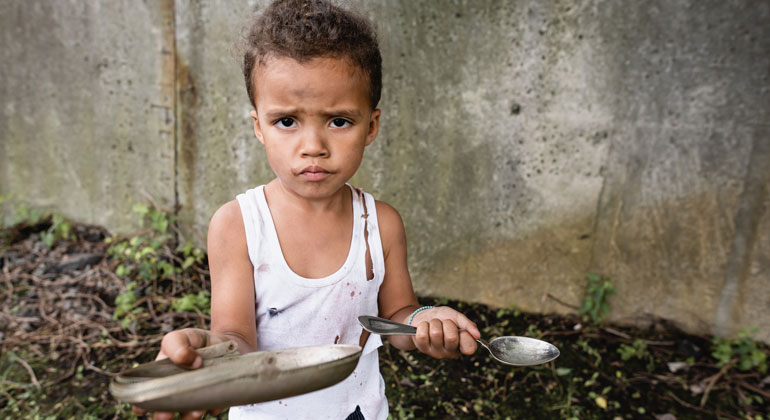Extreme hunger has more than doubled in 10 of the world’s worst climate hotspots over past six years
Less than 18 days of fossil fuel companies’ profits would cover the entire UN humanitarian appeal for 2022
Ten of the world’s worst climate hotspots – those with the highest number of UN appeals driven by extreme weather events – have suffered a 123% rise in acute hunger over just the past six years, according to an Oxfam report published today.
Gabriela Bucher, Oxfam International Executive Director, said: “Climate change is no longer a ticking bomb, it is exploding before our eyes. It is making extreme weather such as droughts, cyclones, and floods – which have increased five-fold over the past 50 years – more frequent and more deadly.”
The brief – Hunger in a heating world– found that those 10 climate hotspots – Somalia, Haiti, Djibouti, Kenya, Niger, Afghanistan, Guatemala, Madagascar, Burkina Faso, and Zimbabwe – have repeatedly been battered by extreme weather over the last two decades. Today, 48 million people across those countries suffer acute hunger (up from 21 million in 2016), and 18 million people of them are on the brink of starvation.
“For millions of people already pummelled down by ongoing conflict, widening inequalities, and economic crises, repeated climate shocks are becoming a backbreaker. The onslaught of climate disasters is now outpacing poor people’s ability to cope, pushing them deeper into severe hunger,” said Bucher.
“Climate change is no longer a ticking bomb, it is exploding before our eyes. It is making extreme weather such as droughts, cyclones, and floods – which have increased five-fold over the past 50 years – more frequent and more deadly.”
Gabriela Bucher, Oxfam International Executive Director
For example:
- Somalia is facing its worst drought on record, and famine is expected to unfold in two of its districts: Baidoa and Burhakaba. One million people have been forced to flee their homes due to the drought. The country ranks 172nd out of 182 countries in terms of its readiness to cope with climate change.
- In Kenya, the current drought has killed nearly 2.5 million livestock and left 2.4 million people hungry, including hundreds of thousands of children severely malnourished.
- In Niger, 2.6 million people are facing acute hunger today (up 767 percent from 2016). Cereal production has crashed by nearly 40 percent, as frequent climatic shocks on top of ongoing conflict have made harvesting increasingly difficult. Production of staple foods such as millet and sorghum could plummet even further by 25 percent if global warming surpasses 2°C.
- Burkina Faso has seen a staggering 1350 percent rise in hunger since 2016, with more than 3.4 million people in extreme hunger as of June 2022 due to armed conflict and worsening desertification of crop and pastoral lands. Global warming above 2°C would likely decrease cereal yields like millet and sorghum by 15–25%.
- In Guatemala, a severe drought has contributed to the loss of close to 80 percent of the maize harvest and devastated coffee plantations.
“We spent almost eight days with hardly any food,” says Mariana López, a mother living in Naranjo in Guatemala’s Dry Corridor. Persistent drought forced her to sell her land.
Climate-fuelled hunger is a stark demonstration of global inequality. Countries that are least responsible for the climate crisis are suffering most from its impact and are also the least resourced to cope with it. Collectively responsible for just 0.13 per cent of global carbon emissions, the 10 climate hotspots sit in the bottom third of countries least ready for climate change.
“We spent almost eight days with hardly any food.”
Mariana López, a mother living in Naranjo in Guatemala’s Dry Corridor
In contrast, polluting industrialized nations such as those of the G20 – which control 80 percent of the world’s economy – are together responsible for over three-quarters of the world’s carbon emissions.
Leaders of these nations continue to support mega-rich polluting companies that are often big supporters of their political campaigns. Fossil fuel companies’ daily profits have averaged $2.8 billion over the last 50 years. Less than 18 days of those profits would fund the entire UN humanitarian appeal for 2022 of $49 billion.
Important policy changes are equally needed to address the double crisis of climate and hunger. Unless massive and immediate action is taken, hunger will continue to spiral.
“Ahead of UN General Assembly meetings this week, and COP 27 in November, leaders, especially of rich polluting countries, must live up to their promises to cut emissions. They must pay for adaptation measures and loss and damage in low-income countries, as well as immediately inject lifesaving funds to meet the UN appeal to respond to the most impacted countries.
“We cannot fix the climate crisis without fixing the systemic inequalities in our food and energy systems. Increasing taxation on super polluters could easily cover the cost. Just 1% of the fossil fuel companies’ average annual profit would generate $10 billion, enough to cover most of the shortfall in funding the UN humanitarian food security appeal,” Bucher said.
Cancelling debt can also help governments free up resources to invest in climate mitigation.
“Rich and most polluting nations have a moral responsibility to compensate low-income countries most impacted by the climate crisis. This is an ethical obligation, not charity,” said Bucher.
- Download Oxfam report Hunger in a Heating World. The FSIN began producing the Global Reports on Food Crises in 2017. Sum of the population in IPC3+ food insecurity in the ten countries in 2016 (See GRFC 2017, p. 21) was 21.3 million and in 2021 (See GRFC 2022, pp. 30 – 33) was 47.5. The percent rise is therefore 123%.
- The calculations of those facing starvation in the 10 countries is based on the total number of people at IPC 4 level of food insecurity and above in 2021, according to the GRFC 2022, see Understanding IPC classification
- The 10 worst climate hotspots were calculated looking at countries with the highest number of extreme weather-related UN appeals since 2000, where climate was classified as a “major contributor” to these appeals. Source: Oxfam’s “Footing the Bill” report May 2022.
- The 10 countries had the highest number of appeals linked to extreme weather, where climate was a major contributor to the appeal, according to the methodology outlined in the Oxfam (2022) Technical Note UN Humanitarian Appeals linked to Extreme Weather, 2000-2021.








